Article written by several authors*
The significant increase in installations of photovoltaic systems connected to the electrical grid occurred after the publication of the Normative Resolution No. 482/2012 from the ANEEL (National Electric Energy Agency), which defined guidelines for the connection and use of photovoltaic sources connected to conventional networks.
Some factors can contribute to increasing the efficiency of a photovoltaic system connected to the electrical grid. Among them are the inclination of the modules, the orientation, and the use of bifacial module technology, which produce energy by collecting solar radiation through the rear and front faces.
The arrival of bifacial module technology contributes significantly to reducing the area used for installation in soil plants, as it takes advantage of reflected light (albedo) to also generate energy.
For the need to carry out computational simulations reliably, using consolidated and validated mathematical models, the software can be used PVSyst. In this study, simulations were carried out in the PVSyst software to investigate the change in energy generated by the photovoltaic system with the change in albedo and variation in ambient temperature.
It was found that the albedo impact in the simulations carried out it provided gains. To consolidate the simulations with real situations, it is advisable to add the seasonal climate factor, over long periods of observation and data collection.
Bifacial modules
Bifacial photovoltaic modules have the ability to collect solar energy on both sides as they are able to absorb additional sunlight from the back surface, which is a significant advantage compared to the traditional photovoltaic module. The energy generated at the rear of the module provides the so-called back side power gain (power gain with the rear).
The real gain obtained in the bifacial module depends on several parameters, such as the type of installation and the surface reflection coefficient, which we know as albedo. With solar radiation collected by the rear surface, there will be more electrical energy generation, as shown in Figure 1.
Bifacial modules can produce up to 30 % more energy compared to conventional modules (Yusufoglu et al, 2015), with the same nominal peak power (Wp). In low light locations, they are capable of producing 15 % more energy than conventional modules (Yusufoglu et al, 2014).
The effect of the incidence of solar radiation on the rear face on the production of electrical energy is defined by the module manufacturer through a factor called “bifacial energy gain”, which depends on the positioning of the modules in the installation (Grafulha, 2016).
The use of bifacial photovoltaic modules improves energy generation in relation to the area occupied by the modules, as it uses reflected light to generate more energy per area, according to Aguiar Coelho (2020).
The gains obtained in the modules by radiation in the rear area can be impacted by the installation method, such as the height between the ground and the modules and the distance between rows, as shown in Figure 2.
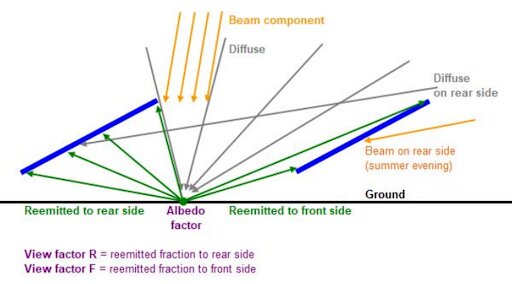

What is Albedo?
In its definition, albedo is the ratio between the flow of reflected and incident solar radiation, and constitutes an important parameter in the study of climate change, desertification, fires and environmental impacts (Silva et al., 2005)
The albedo varies mainly depending on the physical-chemical characteristics of the surface, color, solar zenith angle, among other things. Therefore, for each type of land cover there is a different spectral response, that is, the albedo of bare soil, for example, is different from that of the same soil with vegetation cover.
Bifacial modules use bifacial cells encapsulated with transparent materials on both sides for maximum light absorption. This allows effective use of light reflected from the ground surface. Furthermore, it also helps in reducing the internal temperature of the module, improving its performance (Waaree Energies Ltd., 2017).
The darker the surface, the lower the reflectivity of incident solar rays, resulting in greater absorption of light and less reflection in the surroundings and inside the photovoltaic plant. Depending on the material that makes up the surface or the type of landscape, there is a pre-defined albedo value.
The PVSyst software has reference albedo values, as shown in Table I. The authors VELOSO and ROSA (2013) found values in the caatinga ranging from 20 to 30%, with the highest values corresponding to soils without vegetation. According to the aforementioned authors, these values correspond to those observed by OKE (1987), who found a surface albedo of 40% in desert regions.
For better accuracy in albedo values, it is necessary to carry out annual measurements at the locations of each solar project.
The increase in temperature caused by soil cover can affect generation losses. It is necessary to choose a soil cover that favors the reduction of losses.
Simulations of bifacial systems with PVSyst
According to (RAMPINELLI; KRENZINGER, 2009), in contrast to the difficulties of experimental monitoring, which depend on equipment and measurements, the analysis of a photovoltaic system can be done using software. The software allows the simulation of systems that do not yet exist and makes it possible to change parameters and topologies in a simplified way.
For a computer simulation to have reliable results, it is essential that the mathematical models are consolidated and validated, therefore the PVSYST software was chosen for the simulations in this work.
In this study, two simulations were considered in PVSYST, which aimed to show possible gains in electrical energy generation arising from variations in albedo and ambient temperature.
In the first simulation we used a 236 kWp system, at the location: Latitude: -22.82 degrees S and Longitude -47.07 degrees W, with an altitude of 582 m. The installation was carried out in a fixed structure, facing the geographic north, with the photovoltaic modules inclined at 20 degrees.
The system was designed with 468 505 Wp photovoltaic modules, model TSM-DEG18MC-20-(II)-505-Bifacial, from the manufacturer Trina Solar, containing 5 identical rows and a spacing between rows (pitch) of 7 meters.
One 175 kWac inverter model SUN2000-175KTL-H0, from the manufacturer Huawei, was used. A reflection coefficient (albedo) of 15% was considered and the results shown in Table II were obtained.
In the second simulation, the same system characteristics were considered: peak system power, location, structure, facilities and equipment. In this case, however, an albedo coefficient of 30% was considered. The results obtained are shown in Table III.
In the third simulation, again, the same conditions were considered, but with an increase in ambient temperature of 10º C (Figure 3). The results obtained are shown in Table IV.
In the fourth simulation we consider the same peak power of the system, location, structure, facilities and the same equipment, with the same albedo as in the second simulation. The difference was the increase in ambient temperature by 10º C. The results are shown in Table V.
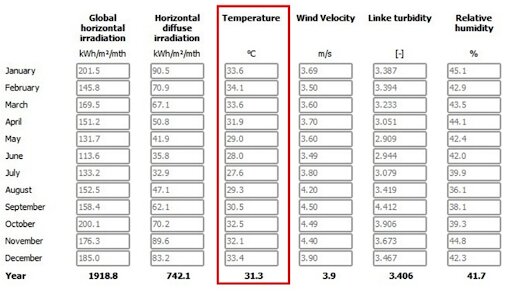
Conclusions
The impact of the Earth's surface albedo was tested in simulations carried out using the PVSyst software.
To validate the simulations, the ideal would be to complement the study with measurements in real environments, which consider an albedo gain and variations in ambient temperature that will provide a true indication of how albedo gains vary and possibly deteriorate over time (see Figure 4).
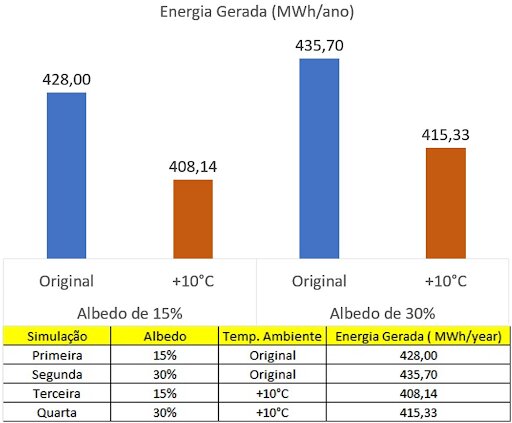
In simulations carried out with albedos of 15% and 30%, the gains in electrical energy generated per year were of the order of approximately 1.77%.
In the simulations carried out with albedos of 15% and 30%, but with an increase of 10 degrees Celsius in relation to the previous cases, at ambient temperature, the gain in the generation of electrical energy generated annually was of the order of approximately 1.73% (see Table VI).
Electrical energy losses due to the increase in ambient temperature have a significant impact, regardless of the albedo, as can be seen in Table VII.
Therefore, according to the results presented, it is very important to establish criteria in the choice of materials used for soil treatment with the aim of increasing the albedo, as there are cases in which the choice of these materials causes an increase in the temperature surrounding the photovoltaic modules, providing negative impacts on the power generation, as shown in Table VIII.
The simulation results show that there are impacts of albedo and temperature on the energy generated, as expected. The results need to be validated through field measurements, to verify the accuracy of the simulations carried out by PVSyst.
In any case, an important conclusion was reached: the search for an increase in albedo must be accompanied by the observation of an increase in the ambient temperature of the photovoltaic plant. Therefore, it is important to look for ways to treat the soil without raising the temperature too much.
This subject should certainly be the subject of more in-depth studies, especially with experimental plants and long periods of observation and data collection.
Additional work would also be needed to understand the aging process of different materials and the level of maintenance this entails. For example, one can study how light reflected from the ground impacts the durability of bifacial modules with backsheet transparent, compared to modules equipped with rear glass.
References
- [1] Aguiar Coelho, G.; Miotto, JL Comparative analysis of the reduction in the photovoltaic energy generation area provided by bifacial modules. Technological Magazine, v. 29, no. 1, p. 242–258, 24 Jan. 2020;
- [2] Cassa, CVL et al. Analysis of the expansion of photovoltaic solar energy in Brazil. [sl: sn];
- [3] Moreira Júnior, O.; Souza, CC DE. Photovoltaic utilization, comparative analysis between Brazil and Germany. Interações (Campo Grande), v. 21, no. 2, p. 379–387, 2020;
- [4] Rampinelli, GA; Krenzinger, A. Description of a computer program for simulating photovoltaic systems connected to the electrical distribution network. [sl: sn];
- [5] Valpecovski Urbanetz, I. et al. Current panorama and 2025 scenario of photovoltaic solar energy in Brazil. [sl: sn];
- [6] Grafulha, MF, Zanesco, I. Comparison of a photovoltaic system with bifacial and conventional modules in a residential condominium. PUCRS. Minutes of the XXXIX Work Meeting of the Argentine Asociación de Energías Renovables y Medio Ambiente Vol. 4, pp. 04.145-04.155, 2016;
- [7] Yusufoglu, UA; Pletzer, TM; Koduvelikulathu, L.J.; Comparotto, C.; Kopecek, R.; Kurz, H. (2015). Analysis of the annual performance of bifacial modules and optimization methods;
- [8] OKE, TR Boundary layer climates. London: Routledge, 1987. 435p;
- [9] PVSYST, Photovoltaic Software (2021). Albedo Values;
- [10] Silva, BB; Lopes, GM; Azevedo, PV de. Determination of the albedo of irrigated areas based on LANDSAT5 – TM images. RevistaBrasileira de Agrometeorologia, v.13, p.201-211, 2005.
Authors
- Bruno Souza Rocha, [email protected]
- Julio Cesar Bento, [email protected]
- Lindomar Santana de Melo, [email protected]
- Lucas Valosio Rebelo, [email protected]
- Victor Soares, [email protected]


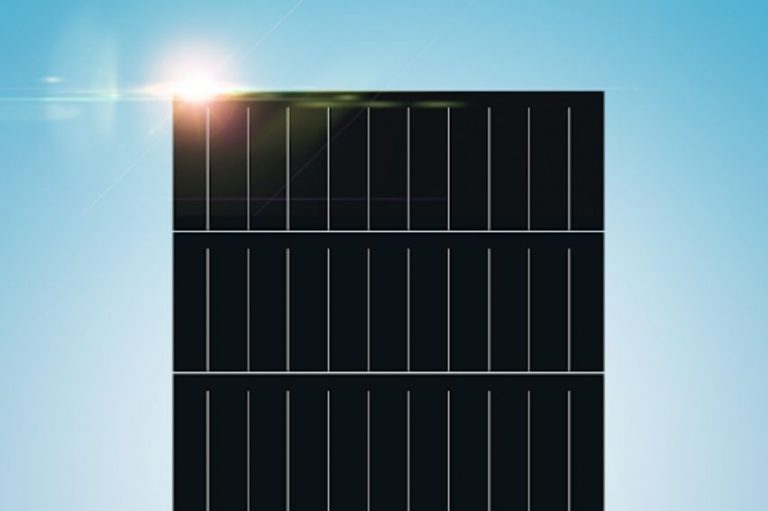
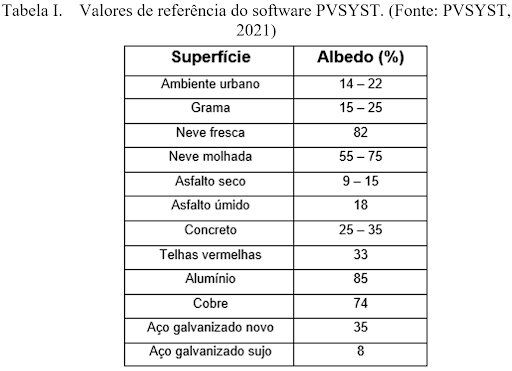


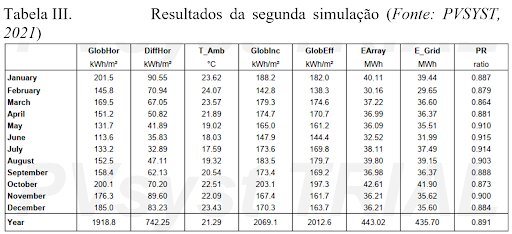
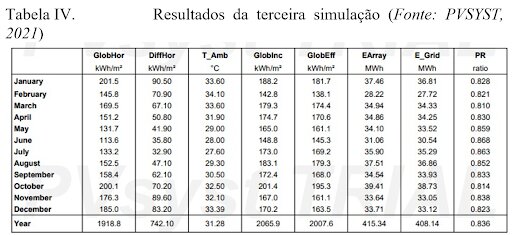
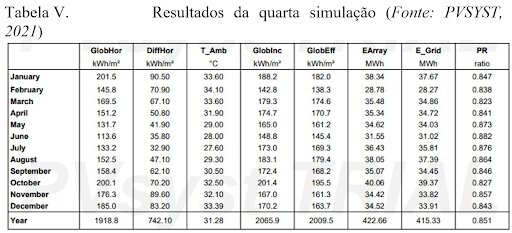














One Response
Congratulations on the excellent work displayed for free. This channel has earned my deep respect! Big hug!